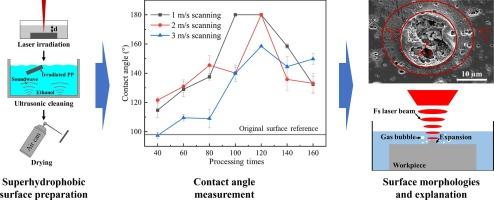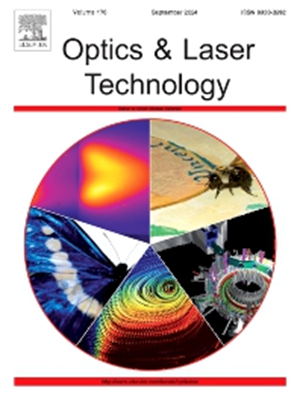在正十六烷液体中通过单步飞秒激光诱导加工实现聚丙烯表面的不粘超疏水性
IF 5
2区 物理与天体物理
Q1 OPTICS
引用次数: 0
摘要
制备用于生物安全的超疏水聚丙烯(PP)表面是食品和医疗行业面临的一项紧迫挑战。我们在正十六烷中采用飞秒(fs)激光诱导微/纳米制绒的单步工艺实现了商用聚丙烯的超疏水性。对飞秒激光纹理加工后的润湿行为分析表明,重复纹理加工 120 次,接触角(CA)超过 150°,滚动角低于 1°,即可获得最佳效果。我们还研究了微/纳米结构在加工过程中的生成、生长和演变,从而确定了微/纳米结构与疏水性之间的直接关系。此外,我们还阐明了 fs 激光脉冲与空气、水和正十六烷中不同材料类型之间的相互作用,以解释在正十六烷中形成的微/纳米结构。本文章由计算机程序翻译,如有差异,请以英文原文为准。

Non-sticky superhydrophobicity on polypropylene surfaces achieved via single-step femtosecond laser-induced processing in n-hexadecane liquid
The preparation of superhydrophobic polypropylene (PP) surfaces for biosafety is a pressing challenge in the food and medical industries. We achieve superhydrophobicity on commercial PP using a single-step process based on femtosecond (fs) laser-induced micro/nano texturing in n-hexadecane. Analysis of the wetting behavior after fs laser texturing revealed that 120 times of repetitive texturing, with a contact angle (CA) exceeding 150° and a rolling angle below 1° yielded optimal results. The generation, growth, and evolution of micro/nanostructures over processing times were investigated to establish a direct correlation between the micro/nanostructures and hydrophobicity. Furthermore, we elucidated the interactions between fs laser pulses and different material types in air, water, and n-hexadecane to explain the formation of micro/nanostructures formed in n-hexadecane.
求助全文
通过发布文献求助,成功后即可免费获取论文全文。
去求助
来源期刊
CiteScore
8.50
自引率
10.00%
发文量
1060
审稿时长
3.4 months
期刊介绍:
Optics & Laser Technology aims to provide a vehicle for the publication of a broad range of high quality research and review papers in those fields of scientific and engineering research appertaining to the development and application of the technology of optics and lasers. Papers describing original work in these areas are submitted to rigorous refereeing prior to acceptance for publication.
The scope of Optics & Laser Technology encompasses, but is not restricted to, the following areas:
•development in all types of lasers
•developments in optoelectronic devices and photonics
•developments in new photonics and optical concepts
•developments in conventional optics, optical instruments and components
•techniques of optical metrology, including interferometry and optical fibre sensors
•LIDAR and other non-contact optical measurement techniques, including optical methods in heat and fluid flow
•applications of lasers to materials processing, optical NDT display (including holography) and optical communication
•research and development in the field of laser safety including studies of hazards resulting from the applications of lasers (laser safety, hazards of laser fume)
•developments in optical computing and optical information processing
•developments in new optical materials
•developments in new optical characterization methods and techniques
•developments in quantum optics
•developments in light assisted micro and nanofabrication methods and techniques
•developments in nanophotonics and biophotonics
•developments in imaging processing and systems

 求助内容:
求助内容: 应助结果提醒方式:
应助结果提醒方式:


